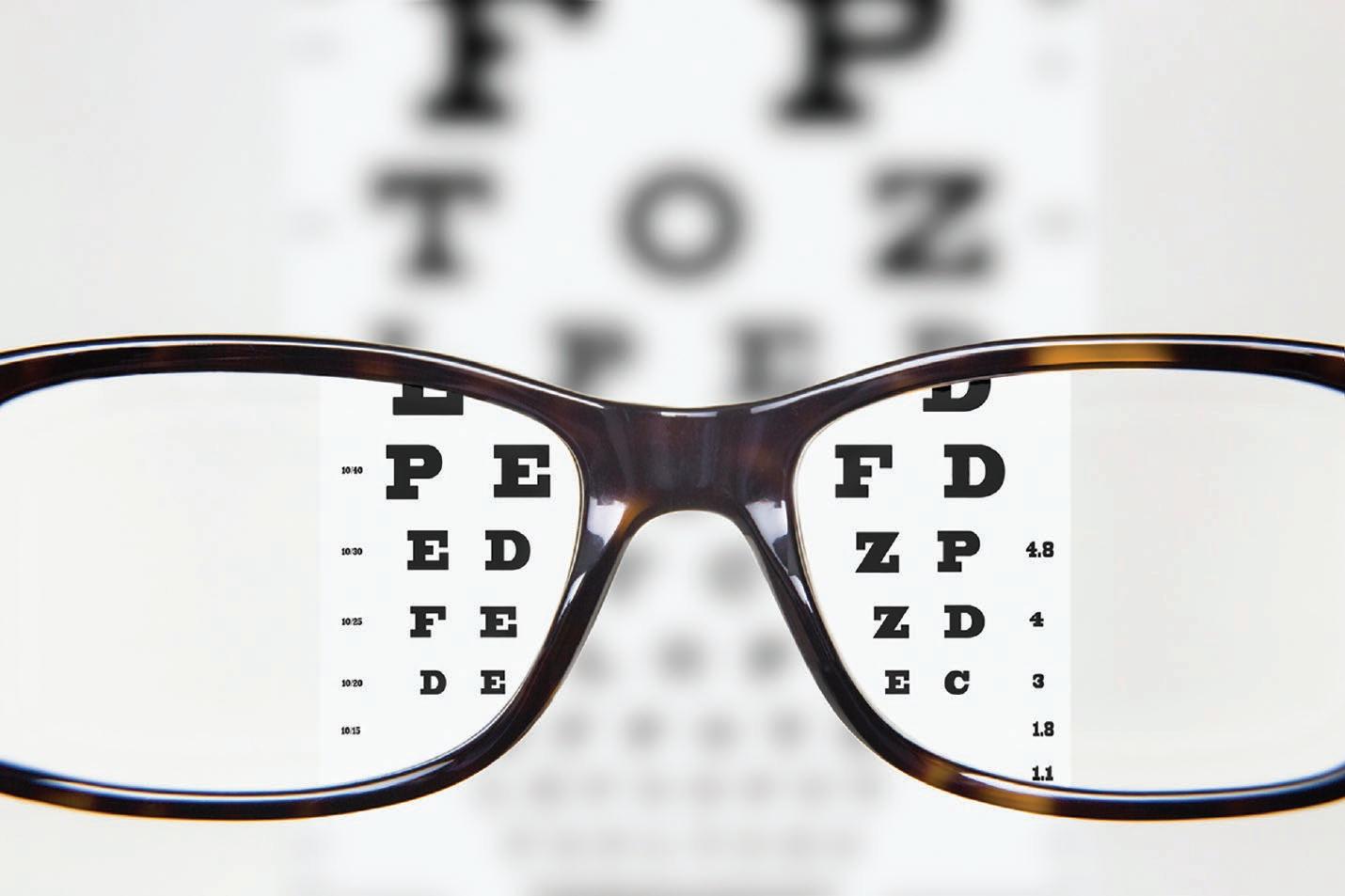9 minute read
Making a Difference – Why Every Dioptre Matters
Mark A. Bullimore PhD, BSc (Hons) MCOptom, FAAO
Eye care professionals (ECPs) may ask why, when we can correct myopia with spectacles, contact lenses and laser refractive surgery, should we worry about slowing its progression?
In the accompanying articles, we have learned about the increasing prevalence around the world,1,2 the sight-threatening consequences of higher levels of myopia,3 and the growing evidence-based literature supporting a variety of management options for its control along woth the risk-to-benefit equation of intervention. Nonetheless, eye care professionals (ECPs) may ask why, when we can correct myopia with spectacles, contact lenses and laser refractive surgery, should we worry about slowing its progression? Bullimore and Brennan propose three evidence-based answers to this question for practitioners and parents alike.4 Central to these issues is the need to care about the long-term visual health of every patient, and not just address their current visual needs. Thus, there are three broad benefits of lowering a patient’s ultimate level of myopia to the long-term care of a patient: • The higher myope will have poorer visual acuity, even when corrected, more difficulty performing everyday tasks, and report more challenges related to their vision. Higher myopes also have a higher incidence of adverse events, probably because they take more risks with their contact lenses.5 • Myopic children may consider laser vision correction as adults. Lower levels of myopia are associated less post-surgical refractive error, with better postoperative uncorrected visual acuity and fewer secondary surgical enhancements. Postoperative visual quality is poorer with greater levels of preoperative myopia.6 • Higher levels of myopia are associated with increased risk of eye disease and visual impairment later in life.7 It is this third issue that is driving interest in myopia management. Reducing the incidence or prevalence of any disease by a meaningful amount is of huge public health significance. Myopia has long been associated with increased risk of cataract, glaucoma and retinal detachment, but the greatest myopia-related cause of irreversible vision loss is myopic maculopathy, also referred to as myopic retinopathy or myopic macular degeneration.8-10 Furthermore, recent research has allowed for the quantification of the risks associated with the level of myopia and we now know that slowing myopia progression by 1 dioptre in children can make a huge difference.
Myopic maculopathy is characterised by stretched blood vessels, peripapillary atrophy, posterior staphyloma, lacquer cracks in Bruch’s membrane, geographic atrophy of the retinal pigment epithelium and choroid, subretinal haemorrhages, and choroidal neovascularisation. These sight-threatening retinal changes occur later in life, but the underlying myopia develops during childhood and has often stabilised by the age of 21.11 Unlike other common eye diseases, it does not have an established treatment.12
Bullimore and Brennan4 combined data from five large population-based studies of the prevalence myopic maculopathy from three continents.13-17 Collectively, these studies represent 21,000 patients, mostly above 50 years old. Figure 1 plots the prevalence of myopic maculopathy as a function of degree of myopia using data are taken directly from the publications. The similarity of the slopes across the five studies is remarkable thanks, in part, to the use of a logarithmic scale. The crude average of the slopes is 1.67x per dioptre. In other words, each dioptre increase in myopia is associated with a 67% increase in the prevalence of myopic maculopathy. Restated, slowing myopia such that a patient’s refractive error is lower by 1 D should reduce the likelihood of them developing myopic maculopathy by 40%, regardless of race or disease definition. This is a huge public health effect. Furthermore, given the constant slope, the treatment benefit should accrue regardless of the level of myopia. Thus, while the overall risk of myopic maculopathy is higher in a –6 D myope than in a –3 D myope, slowing their myopic progression by 1 D during childhood should lower the risk by 40% in both. Finally, we should consider myopic maculopathy a disease of myopia, rather than a disease of high myopia. Myopes below 5 D contribute around half of the cases of myopic maculopathy,13,18 because there are far more myopes at the low end of the refractive spectrum. The same process can be applied to other eye diseases. For example, each additional dioptre of
Figure 1. The prevalence of myopic maculopathy as a function of level of myopia in five studies (redrawn from Bullimore and Brennan).4
myopia is associated with a 20% increase in the prevalence of primary open angle glaucoma and posterior subcapsular cataract. Likewise, each dioptre increases the annual incidence of retinal detachment by 30%.
Myopia and Visual Impairment
With the exception of myopic maculopathy, the aforementioned eye diseases can be managed, but what about the relationship between level of myopia and visual impairment? The data are again compelling. Tideman et al. published the most comprehensive data on visual impairment and myopia, analysing data from 15,404 adults in the Netherlands (mean age 61±11 years) in whom refractive error and visual acuity had been measured.7 In their paper, they plot the cumulative risk of visual impairment as a function of age for five levels of myopia. Their graph was digitized, and the cumulative risk of visual impairment is replotted as a function of myopia level for five ages in Figure 2. The midpoint of each refractive error range was used. On a logarithmic scale, the data show a clear parallel trajectory at all ages. The slopes of the lines are around 1.35x per dioptre, so we can say that, regardless of age, each dioptre of myopia is associated with a 35% increase in the Myopic maculopathy is characterised by stretched blood vessels, peripapillary atrophy, posterior staphyloma, lacquer cracks in Bruch’s membrane, geographic atrophy of the retinal pigment epithelium and choroid, subretinal haemorrhages, and choroidal neovascularisation

By 2050 around one third of all visual impairment will be attributable to myopia and slowing it by one dioptre could reduce the prevalence of visual impairment by 10%
cumulative risk of visual impairment. Likewise, slowing myopia by one dioptre could reduce visual impairment by around 25%.
The relationship among age, myopia and visual impairment can be explored further. For example, in a multivariate model, one dioptre of myopia has the same effect on the risk of visual impairment as two years of aging. Likewise, each additional dioptre of myopia is associated with an extra year of visual impairment experienced by an individual patient. Thus, slowing myopia progression has the potential to improve the quality of an individual patient’s life. In terms of the population, by 2050 around one third of all visual impairment will be attributable to myopia and slowing it by one dioptre could reduce the prevalence of visual impairment by 10%.
A Call to Action
In summary, enthusiasm for myopia management relies on assumption that interventions in childhood will reduce risk of disease later in life and like all major public health issues, myopia requires a coordinated effort and a range of solutions. Indeed, an editorial in the journal of the American Academy of Ophthalmology states that “it is essential for ophthalmologists to work with optometrists, who are frontline providers, to determine a collaborative frame work and referral patterns to prevent myopic progression, educate patients on the risks of myopia, and proactively address associated pathology to serve the best interest of our patients.”19
As described in an accompanying article, there are a range of modalities to slow myopia progression, with more options in the pipeline. Some, though not all, spectacle, contact lenses, and pharmaceutical treatments are effective.20 The choice depends on the age of the child and their lifestyle. A discussion between parent and practitioner will identify what is best for an individual patient.
Myopia management won’t affect the overall prevalence, just the severity of the disease and its consequences to vision. The next decade will likely see the emergence of options to help delay myopia onset. We already know that a child spending more time outdoors lowers the risk, and pharmaceutical and spectacle-based preventive treatments are under evaluation.
In closing, young, myopic children can be offered a range of clinically useful myopia control interventions that have the potential to reduce the risk of visual impairment later in life. Myopia should no longer be considered an inconvenience, but a manageable condition with a narrow window of opportunity to have the biggest impact. Stay informed and connected to remain up to date in this rapidly advancing field.
References:
1 Vitale S, Sperduto RD, Ferris FL, 3rd. Increased Prevalence of Myopia in the United States between 1971-1972 and 1999-2004. Arch Ophthalmol 2009;127:1632-9. 2 Holden BA, Fricke TR, Wilson DA, et al. Global Prevalence of Myopia and High Myopia and Temporal Trends from 2000 through 2050. Ophthalmology 2016;123:1036-42. 3 Verkicharla PK, Ohno-Matsui K, Saw SM. Current and Predicted Demographics of High Myopia and an Update of Its Associated Pathological Changes.
Ophthalmic Physiol Opt 2015;35:465-75. 4 Bullimore MA, Brennan NA. Myopia Control: Why Each Diopter Matters. Optom Vis Sci 2019;96:463-5. 5 Chalmers RL, McNally JJ, Schein OD, et al. Risk Factors for Corneal Infiltrates with Continuous Wear of Contact Lenses. Optom Vis Sci 2007;84:573-9. 6 Bailey MD, Olson MD, Bullimore MA, et al. The Effect of Lasik on Best-Corrected High-and Low-Contrast Visual Acuity. Optom Vis Sci 2004;81:362-8. 7 Tideman JW, Snabel MC, Tedja MS, et al. Association of Axial Length with Risk of Uncorrectable Visual Impairment for Europeans with Myopia.
JAMA ophthalmology 2016;134:1355-63. 8 Hsu WM, Cheng CY, Liu JH, et al. Prevalence and Causes of Visual Impairment in an Elderly Chinese Population in Taiwan: The Shihpai Eye Study.
Ophthalmology 2004;111:62-9. 9 Iwase A, Araie M, Tomidokoro A, et al. Prevalence and Causes of Low Vision and Blindness in a Japanese Adult Population: The Tajimi Study.
Ophthalmology 2006;113:1354-62. 10 Liang YB, Friedman DS, Wong TY, et al. Prevalence and Causes of Low Vision and Blindness in a Rural Chinese Adult Population: The Handan Eye Study.
Ophthalmology 2008;115:1965-72. 11 COMET Group. Myopia Stabilization and Associated Factors among Participants in the Correction of Myopia Evaluation Trial (COMET). Invest Ophthalmol
Vis Sci 2013;54:7871-84. 12 Bourke CM, Loughman J, Fltcroft DI, et al. We Can’t Afford to Turn a Blind Eye to Myopia. QJM 2019. 13 Vongphanit J, Mitchell P, Wang JJ. Prevalence and Progression of Myopic Retinopathy in an Older Population. Ophthalmology 2002;109:704-11. 14 Liu HH, Xu L, Wang YX, et al. Prevalence and Progression of Myopic Retinopathy in Chinese Adults: The Beijing Eye Study. Ophthalmology 2010;117:1763-8. 15 Gao LQ, Liu W, Liang YB, et al. Prevalence and Characteristics of Myopic Retinopathy in a Rural Chinese Adult Population: The Handan Eye Study.
Arch Ophthalmol 2011;129:1199-204. 16 Asakuma T, Yasuda M, Ninomiya T, et al. Prevalence and Risk Factors for Myopic Retinopathy in a Japanese Population: The Hisayama Study.
Ophthalmology 2012;119:1760-5. 17 Choudhury F, Meuer SM, Klein R, et al. Prevalence and Characteristics of Myopic Degeneration in an Adult Chinese American Population: The Chinese
American Eye Study. Am J Ophthalmol 2018;187:34-42. 18 Wong YL, Sabanayagam C, Ding Y, et al. Prevalence, Risk Factors, and Impact of Myopic Macular Degeneration on Visual Impairment and Functioning among Adults in Singapore. Invest Ophthalmol Vis Sci 2018;59:4603-13. 19 Modjtahedi BS, Ferris FL, 3rd, Hunter DG, Fong DS. Public Health Burden and Potential Interventions for Myopia. Ophthalmology 2018;125:628-30. 20 Bullimore MA, Ritchey ER, Flitcroft DI, et al. The Risks and Benefits of Myopia Control. Ophthalmology 2020:submitted for publication.






